The Tombs
- For the 2012 Clive Cussler novel, see The Tombs (novel), for the 1991 Argentine film, see The Tombs (film).
Coordinates: 40°42′59.8″N 74°00′05″W / 40.716611°N 74.00139°W
 | |
| Location | New York City, United States |
|---|---|
| Status | Active |
| Security class | Municipal Jail |
| Opened | 1838 (original building) |
| Former name | Halls of Justice, Manhattan House of Detention |
| Managed by | New York City Department of Corrections |
| Director | Commissioner Joseph Ponte |
The Tombs is the colloquial name for the Manhattan Detention Complex[1] (formerly the Bernard B. Kerik Complex[2]), a municipal jail in Lower Manhattan at 125 White Street, as well as the nickname for three previous city-run jails in the former Five Points neighborhood of lower Manhattan, an area now known as the Civic Center.
The original Tombs was officially known as the Halls of Justice, built in 1838 in the Egyptian Revival architecture style.[1] It was a replacement for the Colonial-era Bridewell Prison located in City Hall Park, built in 1735 and demolished in 1838. The new structure incorporated material from the Bridewell to save money, mainly granite.[3]
The four buildings known as The Tombs were:
- Tombs I, 1838–1902, New York City Halls of Justice and House of Detention
- Tombs II, 1902–1941, City Prison
- Tombs III, 1941–1974, Manhattan House of Detention
- Tombs IV, 1983/1990–present, Manhattan Detention Complex (known as the Bernard B. Kerik Complex from 2001 to 2006)
History
Halls of Justice and House of Detention, 1838–1902
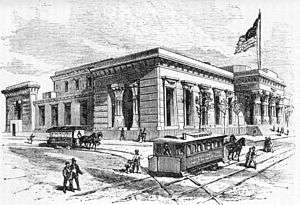
_pg501_THE_TOMBS._THE_PLACE_OF_DETENTION_FOR_CRIMINALS_AWAITING_TRIAL.jpg)
The first complex to have the nickname was an Egyptian Revival design by John Haviland completed in 1838. There was a rumor at the time that the building was inspired by a picture of an Egyptian tomb that appeared in John Lloyd Stephens' Incidents of Travel in Egypt, although this appears to be untrue.[4][5] The building was 253 feet, 3 inches in length and 200 feet, 5 inches wide, and it occupied a full block, surrounded by Centre Street, Franklin Street, Elm Street (today's Lafayette), and Leonard Street. It initially accommodated about 300 prisoners. $250,000 was allocated in 1835 to build the Tombs, but various cost overruns occurred prior to completion of the project.
The building site had been created by filling in the Collect Pond that was the principal water source for Colonial New York City. Industrialization and population density by the late 18th century resulted in the severe pollution of the Collect, so it was condemned, drained, and filled in by 1817. The landfill job was poorly done, however, and the ground began to subside in less than 10 years. The resulting swampy, foul-smelling conditions transformed the neighborhood into a slum known as Five Points by the time that prison construction started in 1838. The heavy masonry of Haviland's design was built atop vertical piles of lashed hemlock tree trunks in a bid for stability, but the entire structure began to sink soon after it was opened. This damp foundation was primarily responsible for its unsanitary conditions during the decades that followed.
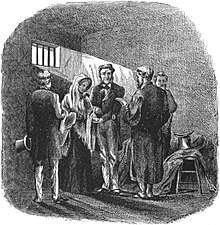

The Tombs' formal title was The New York Halls of Justice and House of Detention, as it housed the city's courts, police, and detention facilities. It was a notable example of Egyptian Revival architecture, although opinion varied greatly concerning its actual merit. Charles Dickens wrote in American Notes: "What is this dismal fronted pile of bastard Egyptian, like an enchanter's palace in a melodrama?"
The prison was well known for its corruption and was the scene of numerous scandals and escapes during its early history. A fire destroyed part of the building on November 18, 1842, the same day that a notorious killer named John C. Colt was due to be hanged. Apparently it was an escape attempt on Colt's part that failed, and he fatally stabbed himself in his cell.[6] Convicted murderer and New York City politician William J. Sharkey earned national notoriety for escaping from the prison disguised as a woman on November 22, 1872. He was never captured and his fate is unknown.[7]
City Prison, 1902–1941
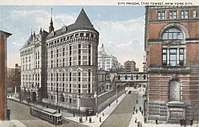
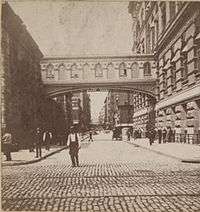
In 1902, the 1838 building was replaced by a million-dollar City Prison featuring an eight-story Châteauesque facade with conical towers along Centre Street, bounded by Centre Street, White Street, Elm Street (today's Lafayette), and Leonard Street.[8] The architects were Frederick Clarke Withers and Walter Dickson from Albany, who had partnered together since the 1880s. This was their final major commission. In September 1900, the architects complained that construction would be delayed for a year and cost an additional $250,000 due to the unnecessary insertion of corrupt Tammany Hall architects Horgan and Slattery into the project.[9]
The building was connected to the 1892 Manhattan Criminal Courts Building with a "Bridge of Sighs", crossing four stories above Franklin Street. There was also an Annex with another 144 cells that had been finished in 1884.
Manhattan House of Detention, 1941–1974
The 1902 prison was replaced in 1941 by a high-rise facility across the street on the east side of Centre Street. The 795,000 square foot[10] Art Deco architecture facility was designed by architects Harvey Wiley Corbett and Charles B. Meyers.[11][12]
The facility is the northern-most of the four 15-story towers of the New York City Criminal Courts Building at 100 Centre Street, bounded by Centre Street, White Street, Baxter Street, and Hogan Place. The three southern towers are wings of a single integrated structure sharing a five-story "crown"[13] which house the city's Criminal and Supreme Courts, city offices, and various departments, including the headquarters of the Department of Corrections. The northern tower is freestanding, with the separate address of 125 White Street. It was officially named the Manhattan House of Detention for Men (MHD), although it was still referred to popularly as The Tombs.
By 1969, the Tombs ranked as the worst of the city's jails, both in overall conditions and in overcrowding. It held an average of 2,000 inmates in spaces designed for 925.[14] Inmates rioted on August 10, 1970, after multiple warnings about falling budgets, aging facilities, and rising populations, and after an informational picket of City Hall by union correctional officers drawing attention to the pressures. Rioters took command of the entire ninth floor, and five officers were held hostage for eight hours, until state officials agreed to hear prisoner grievances and take no punitive action against the rioters.[15] Despite that promise, Mayor John Lindsay had the primary troublemakers shipped upstate to the state's Attica Correctional Facility which likely contributed to the Attica Prison riot about a year later.[16]
Within a month after the riot, the New York City Legal Aid Society filed a landmark class action suit on behalf of pre-trial detainees held in the Tombs. The city decided to close the Tombs on December 20, 1974, after years of litigation and after federal judge Morris E. Lasker agreed that the prison's conditions were so bad as to be unconstitutional. They shipped the remaining 400 inmates to Rikers Island, where conditions were not much better.[17]
Manhattan Detention Complex, 1983/1990–present
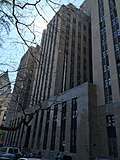
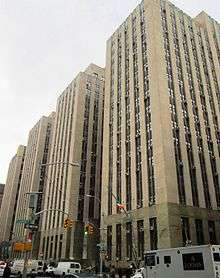
Today, the Manhattan Detention Complex consists of a South Tower, the former Manhattan House of Detention remodeled and reopened in 1983, and a North Tower across White Street, completed in 1990. The complex still houses only male inmates, most of them pretrial detainees. The total capacity of the two buildings is nearly 900 people.[19]
The current Tombs jail was named The Bernard B. Kerik Complex in December 2001 at the direction of Mayor Rudolph Giuliani.[2] Kerik was a well-regarded[20] corrections commissioner from 1998–2000 before becoming police commissioner. Mayor Michael Bloomberg ordered his name to be removed[1] after he admitted to two misdemeanor ethics violations in 2006, dating from his tenure as a city employee.
Notable people
- Edward Coleman, first criminal executed at the prison in 1839
- Rebecca Salome Foster, prison relief worker known as "The Tombs Angel"
- Ernestine Schaffner, prison relief worker known as "The Tombs Angel"
- Vojislav Stanimirović (crime boss) YACS
In popular culture
Film
- The Tombs and the Bridge of Sighs appears in For the Defense (1930) with William Powell
- The Tombs appear in the 1947 film noir, Kiss of Death.
- The Tombs appear in the 2000 remake of Shaft.
- Towards the end of the movie American Gangster (2007), Denzel Washington's character, Frank Lucas, is seen leaving prison after a 15-year sentence. This scene was filmed at the Tombs, although in real life prisoners are held there for relatively brief stays (arraignments, trials, etc.).
Literature and plays
- William Burroughs refers to The Tombs in his semi-autobiographical book Junkie.
- As mentioned above, Charles Dickens disparaged The Tombs' architecture in American Notes (1842).
- In his autobiographical novel Memos from Purgatory, Harlan Ellison describes his brief incarceration in The Tombs following his arrest for possession of a firearm that he had used as a prop while lecturing.[21]
- In the Wild Cards book series, edited by George R. R. Martin with assistance by Melinda Snodgrass, Jay Ackroyd often uses his wild card power to teleport his enemies to the Tombs.
- The Tombs is the setting for the endings of two works by Herman Melville: Pierre: or, The Ambiguities and Bartleby, the Scrivener. Bartleby, apparently by willful starvation, dies on the grassy ground of an open yard in the prison, prompting his former employer to famously exclaim, "Ah Bartleby! Ah humanity!"
- The Tombs is the setting of the play Short Eyes by Miguel Piñero and its film adaptation.
- The Tombs provides the setting for Harry Steeger's 1937 pulp fiction story "Dictator of the Damned", in which The Spider stages a daring raid to help exonerate an innocent man.
- Eric Carter, the main character of Richard Price's novel Lush Life, is incarcerated in the Tombs.
- In The Gilded Age: A Tale of Today, a novel by Mark Twain and Charles Dudley Warner published in 1873, the characters Laura Hawkins and Henry (Harry) Brierly are held in the Tombs after the former has shot a man dead in a New York hotel.
- Front de Liberation du Quebec member Pierre Vallieres wrote White Niggers of America while incarcerated in the Tombs for manslaughter.
Music
- Jim Carroll mentions in his song "People Who Died" that his friend Bobby committed suicide by hanging while in the Tombs. Carroll also mentions the Tombs in his song "Catholic Boy".
- Paul Simon's song "Me and Julio Down by the Schoolyard" includes a threat from the protagonist's father of being placed in the "House of Detention."
- With many elegiac songs about the Lower East Side, New York Hardcore band Agnostic Front has a song called "The Tombs" on their album One Voice.
Radio
- In November 2000, 16 people associated with the Opie and Anthony radio show were arrested and held in The Tombs overnight during a promotion for "The Voyeur Bus", a mostly glass bus carting topless women through Manhattan with a police escort.[22]
Television
- In the TV sitcoms Night Court and Barney Miller, the officers frequently mention that they will take an arrestee to The Tombs.
- The Tombs are featured in season 1 of the 2012 historical drama Copper on BBC America.
- The TV dramas Blue Bloods, Law & Order, Law & Order: Special Victims Unit, and Castle regularly make references to The Tombs. In the SVU episode "Stranger", someone impersonating a long-missing daughter is sent to the Tombs, with the scene-change reading "MANHATTAN DETENTION COMPLEX" and the street address (125 WHITE STREET), as well as the usual inclusion of the calendar date.
- The short-lived comedy-drama The Unusuals mentioned the Tombs in several episodes.
- In the animated TV series Archer, the character Cyril mentions "spending the night in The Tombs, getting worked over by the cops" in the season 2 episode "Stage Two".
- In The Newsroom episode "Oh Shenandoah," Will McAvoy is held at the Manhattan Detention Complex as a result of his contempt citation.
- The Tombs also appears in the TV series The Night Of when the main character played by Riz Ahmed is sent there for murder.
References
Notes
- 1 2 3 Chan, Sewell. "Disgraced and Penalized, Kerik Finds His Name Stripped Off Jail" New York Times (July 3, 2006)
- 1 2 "Mayor Giuliani and Correction Commissioner Fraser rename the Manhattan Detention Complex 'The Bernard B. Kerik Complex'"
- ↑ Carrott, Richard G The Egyptian revival: its sources, monuments, and meaning, 1808–1858 University of California Press, 1978 ISBN 0-520-03324-8 p.165
- ↑ "Doom of the Old Tombs; Soon to be Removed to Make Way for New Prison". The New York Times (July 4, 1896)
- ↑ Carrott, Richard G. The Egyptian Revival: Its Sources, Monuments, and Meaning, 1808-1858. Berkeley, California: University of California Press, 1978. p.165
- ↑ Kernan, J. Frank. Reminiscences of the Old Fire Laddies and Volunteer Fire Departments of New York p.220
- ↑ Walling, George W. Recollections of a New York Chief of Police. New York: Caxton Book Concern, Ltd., 1887. pp.292-296.
- ↑ http://www.nyc-architecture.com/IM-111002/110927-GON072-04.jpg
- ↑ "City Prison Alterations", New York Times, September 7, 1900
- ↑ http://www.newyorklawjournal.com/id=1202475526745/One-Month-After-Blaze-at-Key-NYC-Couthouse,-Miseries-Continue?slreturn=20140126031806
- ↑ Wolfe, Gerard R. (2003) New York, 15 Walking Tours: An Architectural Guide to the Metropolis. (New York: McGraw-Hill Professional ( ISBN 0071411852 ), p.102
- ↑ Department of Citywide Administrative Services, City of New York. "Manhattan Criminal Court Building". Archived from the original on February 21, 2009. Retrieved December 30, 2008.
- ↑ http://skyscraperpage.com/cities/?buildingID=30093
- ↑ Courts, Corrections, and the Constitution: The Impact of Judicial ... edited by John J. DiIulio, page 140
- ↑ Courts, Corrections, and the Constitution: The Impact of Judicial ... edited by John J. DiIulio, page 143
- ↑ States of Siege : U.S. Prison Riots, 1971-1986, by Public Safety Research at the Urban Research Institute University of Louisville, page 26
- ↑ Courts, Corrections, and the Constitution: The Impact of Judicial ... edited by John J. DiIulio, page 149
- ↑ White, Norval; Willensky, Elliot & Leadon, Fran (2010), AIA Guide to New York City (5th ed.), New York: Oxford University Press, ISBN 9780195383867 , p.80
- ↑ "Facilities Overview - Department of Correction". City of New York Department of Correction. The City of New York. Archived from the original on 2014-04-20. Retrieved 2018-03-07.
Manhattan Detention Complex - capacity: 898. This lower Manhattan command consists of two buildings designated the North and South Towers, connected by a bridge. The North Tower was opened in 1990. The South Tower, formerly the Manhattan House of Detention, or the "Tombs," was opened in 1983, after a complete remodeling. The complex houses male detainees, most of them undergoing the intake process or facing trial in New York County (Manhattan).
- ↑ New York Times Topics: Kerik.
- ↑ Wilson, S. Michael (2001-07-22). "Paging Cordwainer Bird..." (Customer review of Memos from Purgatory). Amazon.com. Retrieved 2007-10-10.
- ↑ Rashbaum, William (2000-02-12). "Escort of Voyeur Bus Suspended by Police". New York Times. Retrieved 2007-07-05.
Bibliography
- Gilfoyle, Timothy J. (2003). ""America's Greatest Criminal Barracks": The Tombs and the Experience of Criminal Justice in New York City, 1838–1897". Journal of Urban History. 29 (5): 525–554. doi:10.1177/0096144203029005002. OCLC 88513081.
- Roth, Mitchel P. (2006). Prisons and Prison Systems: A Global Encyclopedia. Westport, Connecticut: Greenwood Press. ISBN 978-0-313-32856-5. OCLC 60835344.
Further reading
- Berger, Meyer (1983) [1942]. "The Tombs". The Eight Million: Journal of a New York Correspondent (Columbia University Press Morningside ed.). New York: Columbia University Press. pp. 23–35. ISBN 978-0-231-05710-3. OCLC 9066227. Retrieved 2007-10-10.
- DeFord, Miriam Allen (1962). Stone Walls: Prisons from Fetters to Furloughs. Philadelphia: Chilton. OCLC 378834.
- Johnson, James A. (2000). Forms of Constraint: A History of Prison Architecture. Urbana: University of Illinois Press. ISBN 978-0-252-02557-0. OCLC 42434965.
- Sifakis, Carl (2003). The Encyclopedia of American Prisons. New York: Facts on File. ISBN 978-0-8160-4511-2. OCLC 49225908.
External links
| Wikimedia Commons has media related to New York City Criminal Courts Building and The Tombs. |
- New York Correction History Society timeline (includes photo)
- An early engraving by John Poppel
- John DePol etching of a later building, 1942
- Painting of 1842 fire at The Tombs
- "Irish in New York" site, Census of prisoners in 1860
- Article on the building complex at the website of the New York Correction History Society